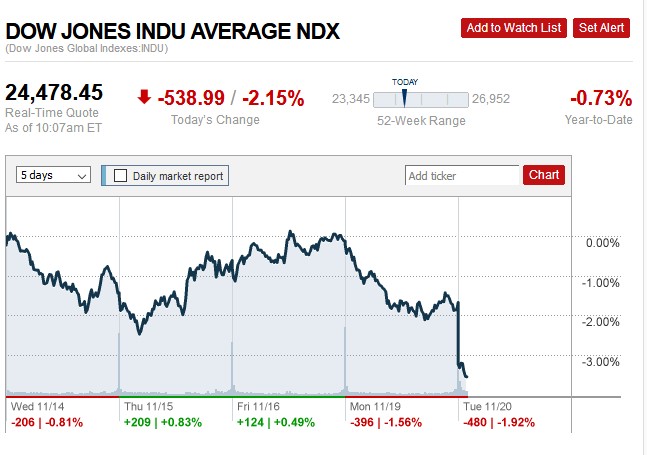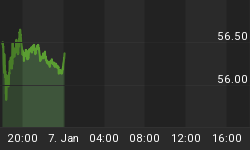For several months now, several leading hedge fund managers and a section of Wall Street have been sounding the alarm over a looming bear market that will eventually kill the longest bull market in stocks history.
Notably, as far back as April, Morgan Stanley declared that we we’re already in the throes of a rolling bear market fueled by an impending sharp slowdown in economic growth, as well as the eventual wearing off of the Trump tax bonanza.
Well, stock prices are starting to agree.
The Dow Jones slipped nearly 400 points in Monday’s trading session, and has dropped another 539 points in early Tuesday trading at 10.07 am ET. That ranks as the second largest selloff by the industrial benchmark since the early February market correction when the index fell more than 1,000 points in a day.
The Dow Jones is widely regarded as a reliable barometer of America's stock market due to its diverse holdings of 30 of the largest companies in industrial, tech, finance, healthcare and telecommunications.

(Click to enlarge)
Source: CNN Money
Few sectors have been as badly hammered as tech, with the tech-heavy Nasdaq Composite Index (COMP) down 4.2 percent over the past five trading sessions, while tech’s best known ETF, XLK, has slipped 5.5 percent over the timeframe.
The tech selloff appears to have been triggered by a spate of poor earnings and/or weak guidance by some of the heavy hitters in the space.
Nvidia has cratered 25.6 percent after issuing poor Q4 2018 guidance, while Apple has slipped 7 percent amid growing fears regarding soft iPhone demand. Related: Europe’s “Link Tax” Could Kill Its Internet Sector
Meanwhile, other FANG stocks are finding themselves mired in the turbulence. Amazon and Netflix are down 9 percent each over the timeframe while Facebook has lost 7 percent.

(Click to enlarge)
Still, the market appears a tad too pessimistic.
The ongoing selloff has been happening smack in the middle of yet another record-setting earnings season.
According to FactSet data, 92 percent of S&P 500 companies have already reported Q3 2018 earnings with 78 percent, exceeding EPS estimates, while 61 percent have beat sales estimates. The blended earnings growth clip of 25.7 percent is a high watermark in eight years, a clear indication that the tax reform has provided a significant boost to most companies’ bottomlines.
Meanwhile, economic growth has been robust by most yardsticks, with U.S. GDP expanding 3.1 percent during the second quarter--the best showing in two years.
It therefore appears that the current selloff is mainly being driven by fears that the best days for the economy are in the rear view mirror, especially with the Fed unrelenting on rate hikes. Interest-sensitive sectors such as auto and housing are already beginning to show signs of strain and it might simply be a matter of time before other sectors of the economy follow suit.
To sell or not to sell?
Despite these ominous signs popping up everywhere, not everybody agrees that they are necessarily a red flag.
Goldman Sachs chief US equity strategist, David Kostin, has reassured investors that rarely do market corrections degenerate into bear markets in the absence of a recession in the last 12 months. He says to buy on the dips since the U.S. economy will continue to outperform those by key rivals despite a slowdown from current levels.
Related: Tech Crunch Drags Markets Lower
Further, some analysts argue that the stock market has way to fall before we are officially in a bear market. The S&P 500 Index (SPX) hit an all-time high of 2,930 in September 20 and has since come down to the current level of 2,650 representing a near-10 percent drop. Technically speaking, the broad market benchmark will have to correct 20 percent from its recent all-time high for it to qualify as a bear market.
Yet, Morgan Stanley equity strategist Michael Wilson has warned investors not to get too cozy on that single data point, saying that 40 percent of S&P 500 companies have already declined at least 20 percent. Wilson says to treat this as a bear market and do just the opposite of that Goldman had advised: sell rallies rather than buy dips.
A word of encouragement though: Wilson says the bear market is cyclical in nature and will happen within a bigger secular bull market. Read: the bear market, if it finally comes to that, will only be short-lived.
By Alex Kimani for Safehaven.com
More Top Reads From Safehaven.com:
















